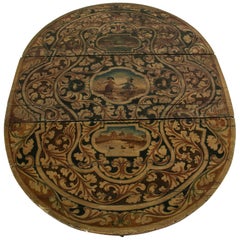Dutch Gateleg Table
Recent Sales
Antique 19th Century Center Tables
Antique Late 17th Century Dutch Drop-leaf and Pembroke Tables
Wood
Antique Mid-19th Century Dutch Dining Room Tables
Oak
Finding the Right Tables for You
The right vintage, new or antique tables can help make any space in your home stand out.
Over the years, the variety of tables available to us, as well as our specific needs for said tables, has broadened. Today, with all manner of these must-have furnishings differing in shape, material and style, any dining room table can shine just as brightly as the guests who gather around it.
Remember, when shopping for a dining table, it must fit your dining area, and you need to account for space around the table too — think outside the box, as an oval dining table may work for tighter spaces. Alternatively, if you’ve got the room, a Regency-style dining table can elevate any formal occasion at mealtime.
Innovative furniture makers and designers have also redefined what a table can be. Whether it’s an unconventional Ping-Pong table, a brass side table to display your treasured collectibles or a Louis Vuitton steamer trunk to add an air of nostalgia to your loft, your table can say a lot about you.
The visionary work of French designer Xavier Lavergne, for example, includes tables that draw on the forms of celestial bodies as often as they do aquatic creatures or fossils. Elsewhere, Italian architect Gae Aulenti, who looked to Roman architecture in crafting her stately Jumbo coffee table, created clever glass-topped mobile coffee tables that move on bicycle tires or sculpted wood wheels for Fontana Arte.
Coffee and cocktail tables can serve as a room’s centerpiece with attention-grabbing details and colors. Glass varieties will keep your hardwood flooring and dazzling area rugs on display, while a marble or stone coffee table in a modern interior can showcase your prized art books and decorative objects. A unique vintage desk or writing table can bring sophistication and even a bit of spice to your work life.
No matter your desired form or function, a quality table for your living space is a sound investment. On 1stDibs, browse a collection of vintage, new and antique bedside tables, mid-century end tables and more .
- What is a gateleg table?1 Answer1stDibs ExpertApril 29, 2020
First introduced in 16th century-England, a gateleg table is a popular kind of table that allowed for intimate dining. The tabletop of the gateleg table, which was initially round or oval versus the long tables and formal seating arrangements that preceded it, had a section that was fixed in place, while one or two sections of the surface were equipped with hinges. By design, a gateleg table could be extended so that more space could be allocated for work or for dining if needed. These hinged sections could be folded back into place on top of the fixed section or could easily be dropped down to hang vertically on their hinges when they weren’t in use. This function, which allowed the table’s drop leaves that weren’t in use to be pushed up against a wall, saved space in small homes because the table could be tucked away. Pivoted legs under the table — which formed a gate as they were joined at their tops and bottoms by crosspieces — supported the hinged sections.
- What does a gateleg table mean?1 Answer1stDibs ExpertMarch 16, 2020
“Gate” in “gateleg table” refers to the pivoted leg supports under the table that are connected at their ends by crosspieces. When raised, the table’s two drop leaves, which are usually D-shaped, are supported upon these gates. When gateleg tables originated in England in the 16th century, they were oval or round and were generally named after their shape (and weren’t yet called gateleg tables) in order to distinguish them from the long tables they’d replaced, as dining had by then been relegated to meals for the family, not an entire household and assembled guests.
- 1stDibs ExpertFebruary 17, 2023The difference between a gateleg table and a drop leaf table is the design of the section that you can raise to expand the piece. On a drop leaf table, the extension does not have any lower support. A gateleg table has a leg that swings out to rest beneath the extension. Find a selection of tables from some of the world's best sellers on 1stDibs.
Read More
20 Inviting Dining Rooms Perfectly Arranged for Entertaining
Top interior designers show — and tell — us how to create delectable spaces for hosting dinner parties.
This Alain Delon–Designed Table Is Almost as Handsome as He Was
Fans of the French film star may be surprised to learn that he had a flair for furniture with sleek lines and disco-era flash.
Uchronia’s Plant Stand Gives Pots a Pretty Perch with All the Trimmings
Like other pieces in the firm’s Candy Box collection, the cheerful limited-edition design showcases French craft.
The Ultimate Guide to Types of Tables for the Home
Whether you’re just moving in or ready to give your home a makeover, our guide will give you pointers on tables that are fitting for every room, nook and hallway.
Is Lionel Jadot the Willy Wonka of Upcycled Belgian Design?
From his massive collaborative workshop in a former paper factory, the designer concocts funky furniture from disused materials, as well as luxe hotel interiors like the new Mix Brussels.
Inspired by the Cosmos, Sandra Nunnerley’s Nova Table Has a Futuristic Feel
The designer’s innovative use of an unexpected material gives this console a lift.
This 19th-Century Gilded Desk Displays a Fanciful Kingdom in Marquetry
The stately piece brings both gravitas and whimsy to any work space.
In Guadalajara, These Luscious Side Tables Are Chiseled from Volcanic Rock
Use them as tables or stools, indoors or out.

